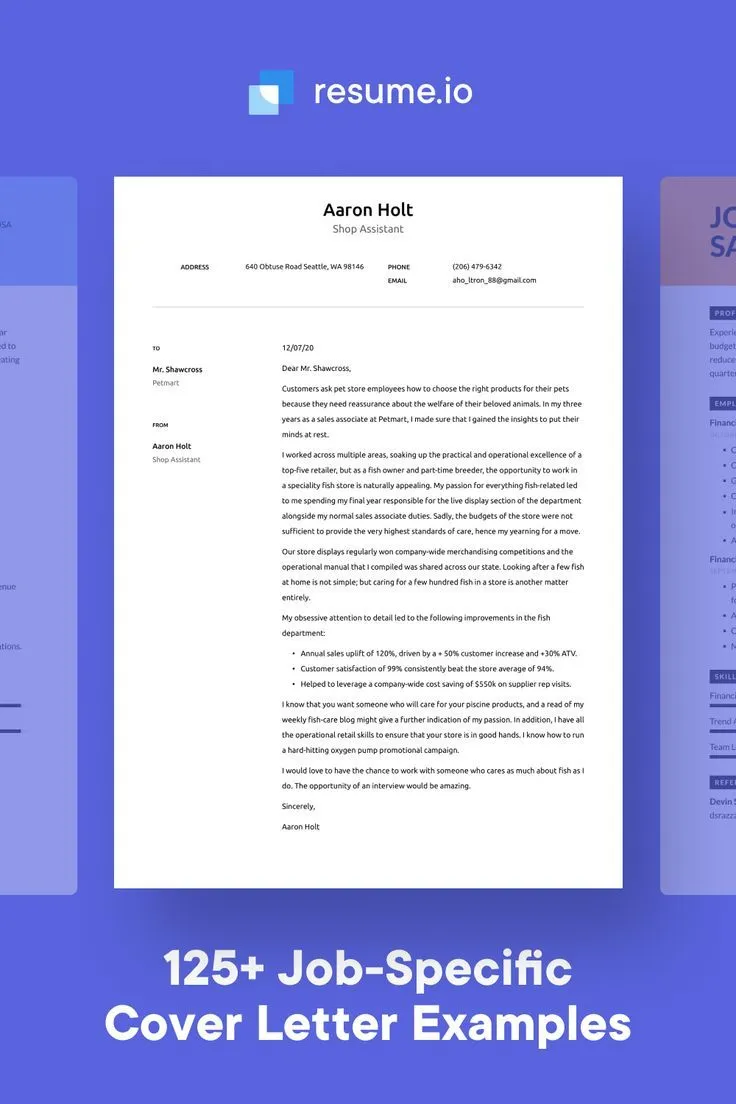Why a Cover Letter Matters for Sales Associates
In the competitive world of sales, a compelling cover letter can be the key that unlocks your dream job. A well-crafted sales associate cover letter goes beyond simply reiterating your resume; it provides a platform to showcase your personality, enthusiasm, and specific skills that align with the job requirements. While your resume lists your experience and qualifications, your cover letter tells the story of why you’re the perfect fit for the role and the company. It’s your chance to make a strong first impression and stand out from other applicants. Failing to submit a cover letter, or submitting a generic one, can signal a lack of attention to detail and a lack of genuine interest in the position.
Grabbing Attention
The first few sentences of your cover letter are crucial. You need to immediately capture the hiring manager’s attention. Start with a strong opening statement that reflects your excitement for the role and your understanding of the company’s mission or values. Avoid generic phrases such as ‘I am writing to express my interest…’ Instead, try something more engaging, such as ‘I was thrilled to see the Sales Associate position at [Company Name] because…’ or ‘My passion for sales, combined with my experience at [Previous Company], makes me a strong candidate for this role.’ Tailor this opening to each specific job application to demonstrate your genuine interest and knowledge of the company.
Highlighting Relevant Skills
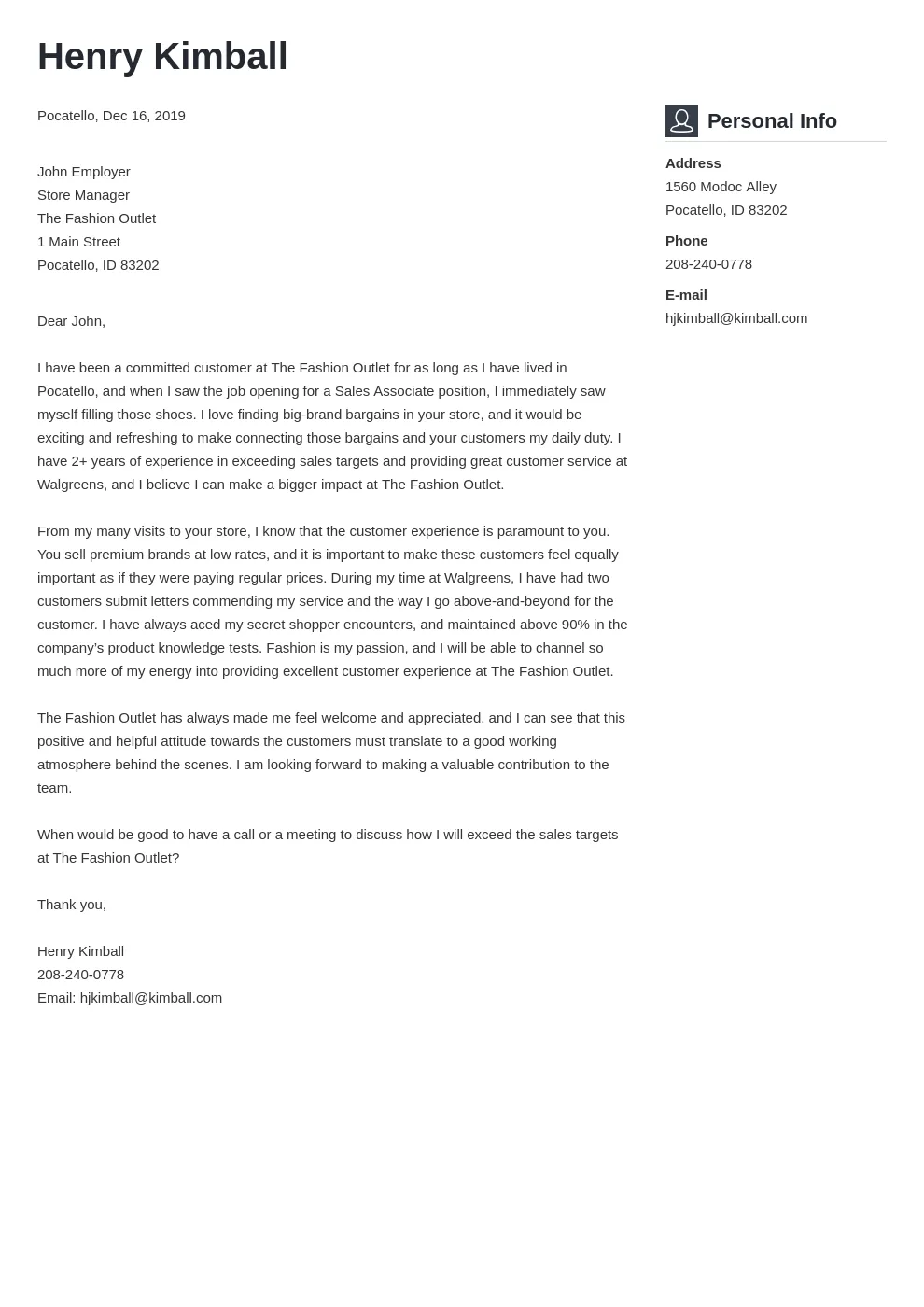
Sales roles require a diverse set of skills, and your cover letter is the perfect place to highlight them. Focus on the skills most relevant to the specific job description. These might include communication, persuasion, negotiation, active listening, problem-solving, and customer service. Provide specific examples of how you’ve used these skills in the past. For instance, instead of saying ‘I have strong communication skills,’ you could write ‘In my previous role, I successfully closed an average of X sales per month by effectively communicating product benefits and addressing customer concerns.’ Quantifiable achievements and specific examples make your claims more credible and demonstrate your value to the employer. Emphasize skills that show your ability to generate leads, close deals, and build customer relationships.
Demonstrating Passion
Sales is a field where passion and enthusiasm are contagious. Your cover letter should reflect your genuine interest in the role, the company, and the industry. Explain what motivates you in sales, what you enjoy about interacting with customers, and why you are drawn to this particular opportunity. Show that you are eager to learn, grow, and contribute to the team’s success. This might include discussing your knowledge of the company’s products or services, your admiration for its brand, or your understanding of its target market. Be specific and authentic in your expression of enthusiasm. A passionate candidate is more likely to resonate with the hiring manager and stand out from the crowd. Don’t be afraid to inject a little of your personality into the letter while maintaining a professional tone.
Understanding the Structure of a Sales Associate Cover Letter
A well-structured cover letter is easy to read and effectively communicates your qualifications. Adhering to a standard format demonstrates professionalism and respect for the hiring manager’s time. Although there is flexibility, understanding the basic structure provides a solid foundation for creating a compelling letter. Following a clear and organized structure helps ensure you present your information in a logical and impactful way. A standard cover letter should include all essential components, from your contact information to a strong call to action. It’s an investment of time that can significantly boost your chances of landing an interview.
Contact Information
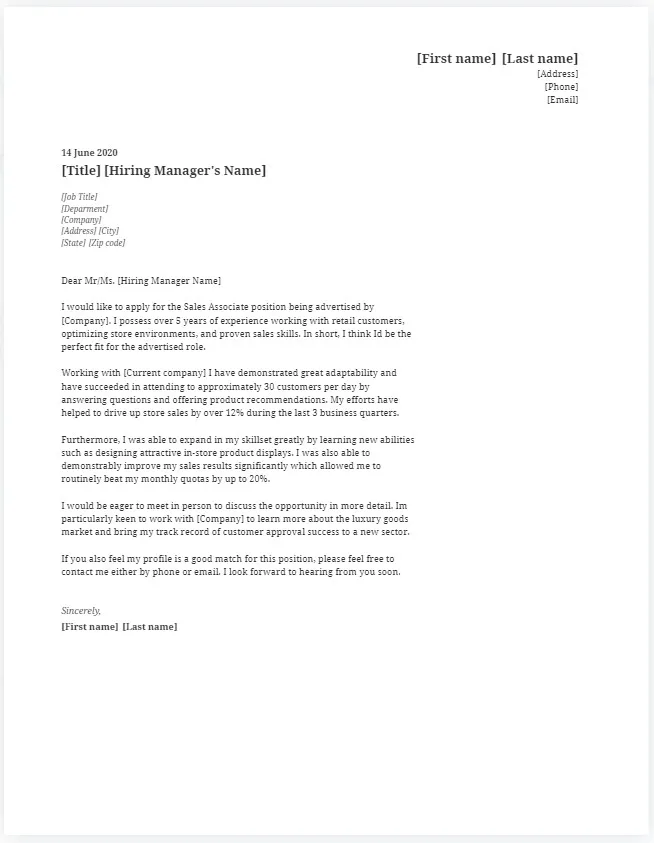
Begin your cover letter with your contact information. This includes your full name, phone number, email address, and optionally, your LinkedIn profile URL. Ensure that your email address is professional and easy to remember. Place your contact information at the top of the letter, either on the left or right side, or in the header. This allows the hiring manager to quickly and easily reach you if they want to schedule an interview. Accuracy here is crucial, as any errors could result in the loss of a potential opportunity. Proofread this section carefully to prevent any mistakes.
Greeting the Hiring Manager
Always address the hiring manager by name if possible. Research the company and job posting to find the name of the hiring manager or the recruiter. Using a name personalizes your letter and shows that you’ve taken the time to do your research. If you are unable to find a name, use a general greeting such as ‘Dear Hiring Manager’ or ‘Dear [Company Name] Hiring Team.’ Avoid overly formal or casual greetings, such as ‘To Whom It May Concern’ or ‘Hey there’. A professional greeting sets the tone for the rest of your letter and demonstrates your respect for the hiring process. This small detail can make a big difference in making a positive first impression.
Opening Paragraph
The opening paragraph is your chance to grab the reader’s attention. State the position you’re applying for and how you found the job. Briefly mention why you’re interested in the role and the company. Your opening should be concise and enthusiastic, highlighting your key qualifications and demonstrating your understanding of the company’s needs. This section should immediately make the reader want to learn more about you. Aim to demonstrate your excitement and establish your interest from the beginning. This sets the tone for the rest of the letter and prepares the hiring manager to view your qualifications in a positive light.
Body Paragraphs
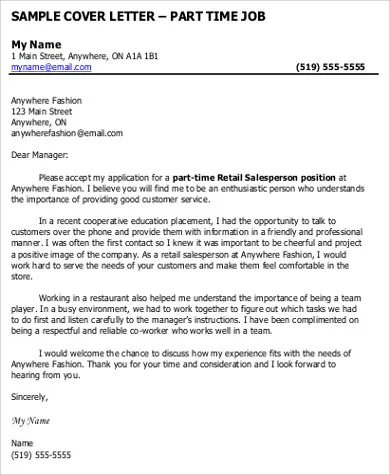
The body paragraphs are the meat of your cover letter. This is where you provide details about your skills, experience, and accomplishments. Use these paragraphs to explain why you’re a good fit for the job, using specific examples and quantifiable results whenever possible. This section needs to be clear, concise, and compelling, detailing how your past experiences align with the requirements of the sales associate role. Tailor the information to the job description, emphasizing the skills and experiences most relevant to the specific position. Avoid simply restating your resume. Instead, use the cover letter to elaborate on your qualifications and provide context. Keep paragraphs short and easy to read.
Skills & Experience
In this section, highlight the skills and experience that make you a strong candidate for the sales associate position. Focus on skills mentioned in the job description, such as customer service, communication, product knowledge, and sales techniques. Describe your experience in similar roles, emphasizing your achievements and responsibilities. Mention any specific training or certifications you have that are relevant to the position. Include specific examples of situations where you’ve used these skills to achieve success. If the job emphasizes teamwork, provide examples of your ability to collaborate with others to meet sales goals. Be specific, not general, in describing your skills and experiences.
Quantifiable Achievements
Whenever possible, quantify your achievements with numbers and data. Use metrics such as sales figures, customer satisfaction scores, or the percentage of sales growth you achieved. This demonstrates the impact of your contributions and gives the hiring manager a clear understanding of your value. Instead of saying ‘Increased sales,’ say ‘Increased sales by 15% in six months.’ Use numbers to back up your claims. This makes your claims more credible and demonstrates your ability to generate results. If you don’t have direct sales experience, you can still quantify your achievements. For example, mention any process improvements that led to increased efficiency or reduced costs. Demonstrating results is key in sales, so showing your ability to quantify accomplishments in your cover letter can boost your application.
Closing Paragraph
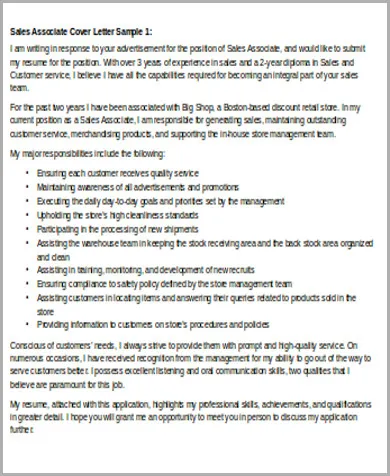
In your closing paragraph, reiterate your interest in the position and thank the hiring manager for their time and consideration. Briefly summarize why you’re a great fit for the role and company. Express your enthusiasm for the opportunity and a willingness to discuss your qualifications further in an interview. End your cover letter with a professional closing, such as ‘Sincerely’ or ‘Best regards,’ followed by your name. This final section should reinforce your key selling points and leave the hiring manager with a positive impression. Make sure to thank them for taking the time to review your application.
Call to Action
Include a clear call to action. State your availability for an interview and how you can be reached. You could also reiterate your enthusiasm for the position and the company. This call to action encourages the hiring manager to take the next step. Make it easy for the hiring manager to contact you by including your phone number and email address. A strong call to action shows your proactive nature and your interest in moving forward in the hiring process. It’s the final step to make sure the hiring manager takes the next step and contacts you.
Formatting Your Cover Letter
The formatting of your cover letter is just as important as its content. A well-formatted letter is easy to read, professional, and demonstrates your attention to detail. Following a consistent format shows respect for the hiring manager. The formatting of your letter contributes to the overall impression you make on the hiring manager. Poor formatting can detract from your qualifications and make the letter appear unprofessional, while good formatting ensures a positive reading experience.
Choosing the Right Font
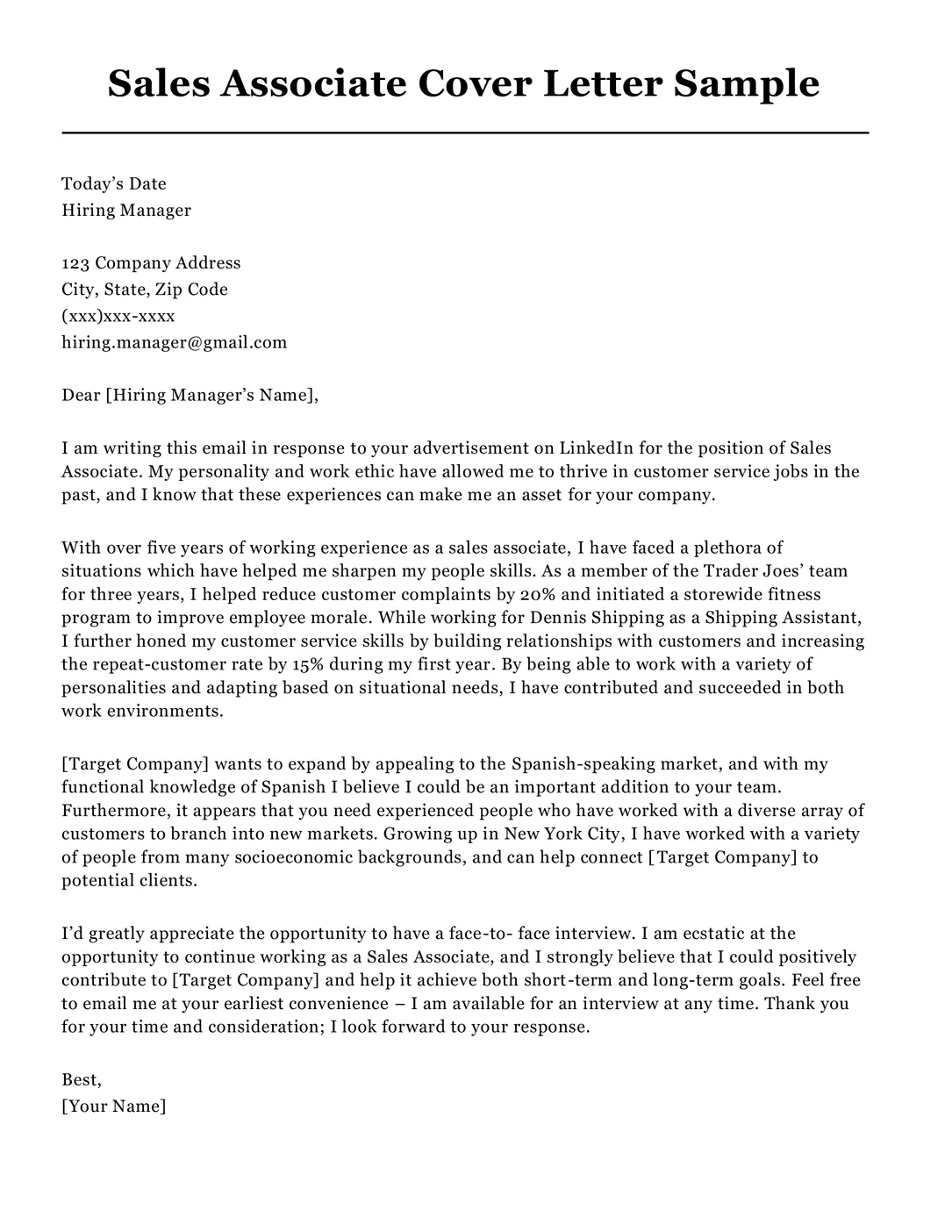
Choose a professional and easy-to-read font. Times New Roman, Arial, Calibri, and Helvetica are all good choices. Use a font size between 10 and 12 points for the body of your letter. Avoid using overly decorative or unusual fonts. This improves readability and ensures your letter looks clean and professional. Using a legible font makes it easier for the hiring manager to read your letter, and shows attention to detail. The right font choice sets the tone for a professional document.
Maintaining Readability
Use clear spacing and formatting to make your cover letter easy to read. Use single-spaced paragraphs with a blank line between each paragraph. Use left alignment, and avoid justifying the text unless it is absolutely necessary. Use bullet points to highlight key achievements or skills. Avoid long blocks of text. Break up the content with headings and subheadings. This makes your cover letter more visually appealing. A well-formatted cover letter is more likely to be read and appreciated by the hiring manager. Readability is key to communicating your message.
Proofreading and Editing
Before submitting your cover letter, carefully proofread and edit it for any errors in grammar, spelling, and punctuation. Errors can make you look careless and unprofessional. Have someone else review your cover letter as well, as a fresh pair of eyes can often catch mistakes you might miss. Use a grammar checker to help identify errors. Proofread several times, and read it aloud to catch any awkward phrasing or typos. A polished cover letter demonstrates your attention to detail and enhances your chances of making a positive impression. Ensure that your cover letter is free of any errors before you send it to the employer.
